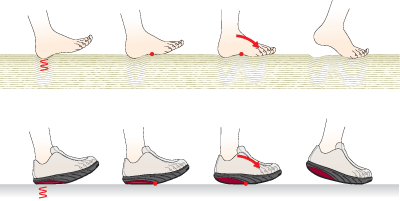- No products in the cart.
How Do Our Feet Function?
The human body is like a complex machine, there are hundreds of different bones, muscles, joints and systems that must work together to help us function properly. Many of these elements team up to allow us to perform even the most simple actions, such as brushing ones hair, scratching an itch or jumping over a puddle. When most people think of the more complex functions of the human body, they often think of the heart, brain or other major organs. Not much emphasis is placed on the foot, or any of our extremities for that matter. So Stikii decided it would be worth our while to give a shout out to those things we call feet, and tell you a bit more about what makes them “kick”!
The human foot contains 26 bones, 2 sesamoid bones, 33 joints, 19 muscles and 107 ligaments. We have two feet, so multiply those numbers by two and you will see that our feet are made up of 52 bones, 66 joints, 38 muscles and, well….you get the picture.
The major components of the foot are usually separated into three different parts (Arthritis Research UK):
- Hindfoot (the back of the foot) – this includes the heel bone (calcaneus) and ankle (talus) which are connected by a joint that allows the foot to move ( like in the song, “the foot bone’s connected to the ankle bone….”)
- Midfoot (the front of the foot) – made up of five tarsals in the arch of your foot. They connect the hindfoot to the forefoot via arch ligaments (planter fascia)
- Forefoot (front of the foot) – includes your metatarsals and phalanges (toe bones)
*Can you find all of these parts in the image above?
Each and every step that we take requires the components of the foot to work together in synchronization. When you are standing immobile, the weight of your body is evenly distributed along your foot, and the planter fascia (arch ligaments!) is a bit relaxed. Once you begin to walk, the heel touches the ground first and absorbs the impact of your body weight, and as the remaining part of the foot hits the ground, the weight shifts to the ball of the foot and then, finally, to your toes (phalanges!).
During this movement, the arch of the foot partially flattens, which stretches the planter fascia. Then, your weight shifts once more as you begin to rise onto your toes and the ball of your foot while the Achilles tendon (that is located on the back of the ankle/heel) lifts your ankle and your body is propelled over that first foot. When this occurs the body weight is then passed on to the other foot.
And that, Stikii friends, is how our feet work and allow us to walk! Speed up the process and you can jog or run!
Due to the position and function of our feet, they are exposed to various infections and injuries. There is also the possibility that a genetic disorder could affect the shape and function of the feet. Thus, it is important that we protect our feet by wearing proper shoes, and keep them healthy and clean. In the coming weeks, Stikii will educate you on how to keep your feet healthy and safe, and provide you with a bit more information on the structure of our own shoes. All of this will lead us into April 2013 which happens to be National Foot Health Awareness Month! By then, you should all know a bit more about these crucial limbs that allow locomotion of the human body.
Stay tuned!




